- Home
- New Kyurizukai
- Micro-and Nano-Engineering
from Keio's Faculty of Science and Technology
Micro-and Nano-Engineering
from Keio's Faculty of Science and Technology
Opening up new horizons of manufacturing
- micro devices revolutionize the world.
Leading MEMS studies with the spirit, “Conceive like an amateur and do the job professionally.”
“I hate the word ‘setback’,” says Dr. Norihisa Miki. In Japanese, “setback” is written in two characters: “being disheartened” and “breakdown.” He maintains a belief that you’ll be okay if you are not broken tally when you experience a setback. With his inquisitive character coupled with a challenger’s spirit and inborn brightness, Dr. Miki is pushing forward through his career as a research scientist. Under a motto of “Enjoy what you’re doing,” he strives to open up new horizons for MEMS, demonstrating his unrestricted power of conception and taking advantage of substantial achievements he has accumulated.
Norihisa Miki
Based on MEMS (Microelectromechanical Systems) technology, Dr. Miki is developing diverse research activities in fields ranging from ICT and medical care to environmental conservation. Born in 1974 in Tatsuno City, Hyogo Prefecture. Completed the Doctor’s Course, School of Engineering, The University of Tokyo in 2001. From 2001 to 2004, he served as a postdoctoral fellow and research engineer at MIT’s Department of Aeronautics and Astronautics. From 2004 on, he works for Keio University as Assistant Professor. As for pastime, he was keen on heavy metal rock music as a high school boy, mahjong and fishing as a college student, and golfing thereafter.
Introducing Researchers
Featured in this issue is Assistant Professor Norihisa Miki who challenges the development of MEMS-based devices, which have heretofore been impossible to develop with existing technologies.
Creating New Devices with MEMS
Opening up new horizons of manufacturing
Imagine a bedridden patient, who wants to drink a cup of tea, can communicate his/her intention to others by simply turning his/her eyes to a pot and tea cup. If we can understand what the elderly and small children tend to look at while moving around town, it will contribute to safety-assured urban planning. Or if consumers can get a feel of products shown on a display screen, possibilities for Internet shopping will greatly expand ...
Attempts are now being made to digitize sensory information (visual sensation, tactile sensation, etc.) for application in communication. MEMS(Microelectromechanical Systems) plays the central role in the manufacturing of such key devices. In this issue we listened to Assistant Professor Norihisa Miki, Department of Mechanical Engineering, Keio University Faculty of Science and Technology, who is actually making such devices using MEMS.
MEMS technology plays an active role in the industrial world
Some two decades has passed since AT&T's Bell Telephone Laboratory in the United States launched in 1987 a silicon micro gear less than 0.2mm in diameter. During this period, MEMS (Microelectromechanical Systems) has steadily evolved and grown into a technology indispensable for today's industrial world. A fine example of a MEMS-applied product in our daily life is portable electronic game consoles. For example, as you incline a game console, a ball drawn in the screen begins to roll. But the rolling ball comes to a halt as you bring the console back to a horizontal position. MEMS technology can make such sensory movements more realistic. It is also applied extensively to many other fields that impact our lives, including automobile air bag motion control.
“MEMS technology is contributing immensely to innovation of the measuring instrument technolog y that covers impact detection sensors, acceleration sensors and flow rate sensors. Indeed, its application ranges from automobiles to cellular phones. Perhaps you may know of a game played by swinging a controller like a baseball bat or tennis racket. This game incorporates MEMS technology,” remarks Dr. Miki.
MEMS is a technology indispensable to “manufacturing” activities that require precision of a micromillimeter. Taking advantage of this technology, the Miki Laboratory is pursuing the development of devices that offer truly innovative functions.

Detecting our lines of sight
The Miki Laboratory addresses a wide scope of research fields ranging from information/communication to medical care and welfare. This extensive scope reflects the wide range of MEMS applications. One of the research endeavors at the Miki Laboratory is an attempt to make human line of sight as an interface device in place of keyboards and touch panels.
“Many studies have been conducted so far on detection of human line of sight. However, most of these endeavors involved the use of large-scale equipment like setting a camera in front of the subject, which often caused mental stress on the subject. This is why I wanted to develop a system that allows us to conduct such experiments as naturally as possible while significantly reducing the burden on the subject.”
When conceiving how to detect line of sight, a concrete image of an application Dr. Miki had in mind was the “scouter” appearing in the popular animation “Dragon Ball.” The scouter is an advanced tool resembling the monocle that was in fashion in Europe in the 19th century. If one stares at an object through the lens, the scouter recognizes the object in front of the line of sight. It then digitalizes pieces of information such as the object's battle capability, the distance and direction from the scouter to the object, and displays the information on the lens.
“Equipment almost comparable to the scouter wouldn't only be a dream if we had a technology capable of accurately determining human line of sight. Convinced that such equipment would blossom into a promising technology, I made up my mind to develop a line of sight detecting device based on MEMS. This detector would allow one to complete the process of information acquisition only by looking at the object. For example, the line of sight would point to the object, staring for a single click and two winks for a double click,” says Dr. Miki delightfully. But he is actually serious and highly motivated, saying “I conceive like an amateur and achieve the project with professional technology.”
The Miki Laboratory thus embarked on the development of a spectacle-type line of sight detection system. A new method was devised to locate the eye pupil positions. In this method, transparent micro optical sensors are arranged at regular intervals on the left and right lenses. Information from these sensors is analyzed to detect the line of sight.
The task of arranging micro sensors on glasses - extremely difficult with the existing technology - could happen thanks to MEMS, which led to the development of a spectacle-type, easy-towear line of sight detection system. Much is expected of this system as an innovative communication tool and human interface device.
Reproducing tactile sensation
Application of the MEMS technology is not limited to digitalization of human sensibility as the line of sight detection system does. It is also applied to the development of devices that allow stimuli to be input directly into the human skin. One such example is the tactile sensation display.
“Although visual and audio programs that stimulate human visual and auditory senses have been highly developed, the field of tactile sensation has long remained dormant. This is because physical stimuli had to be applied directly to the skin. Tens to some 100 microns of change in momentum is required for a human to feel a stimulus. However, MEMS, which is geared to handling a stimulus in units of several microns, is not good at handling momentum changes in units of tens of microns. This posed a problem.”
In order to solve this problem, he developed an actuator by applying the principle of a hydraulic system - a system capable of amplifying momentum of several microns to 100 microns. This led to the development, though at the lab level, of a highly practical braille display system.
“Recent studies indicate that the human skin can feel a stimulus with much less energy if you apply the stimulus with fine vertical vibrations, rather than simply pressing it against the skin. I'm now engaged in research one step ahead, assuming that even less energy would be required if spatial vibrations - horizontal and vertical - were added. Fine motion is a field MEMS is good at, you know ...”
Based on these achievements, Dr. Miki plans to bring to light how humans will recognize tactile sensation through various kinds of stimuli given.
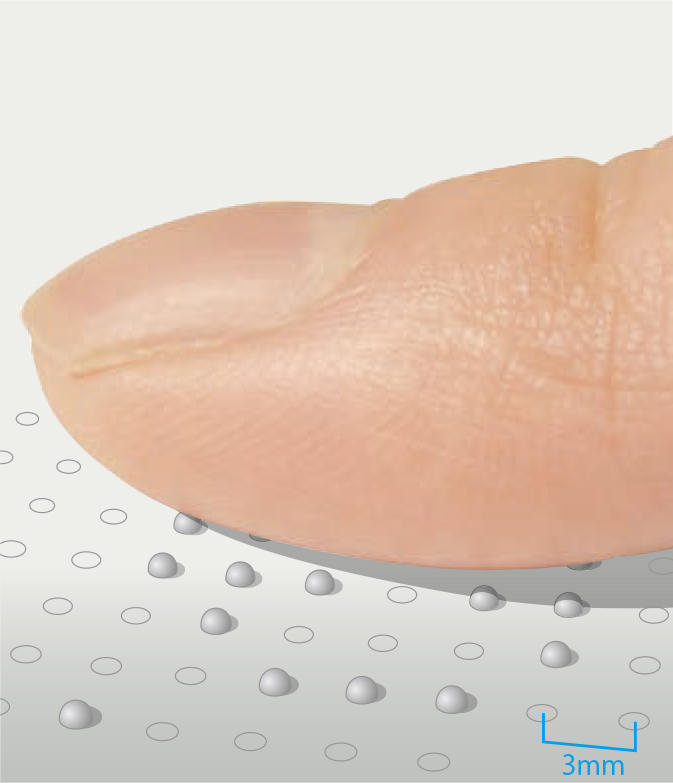
Basic mechanism of the tactile sensation display
Although the surface of the tactile sensation display is normally flat, stimulus-presenting elements pop up as the micro actuator begins to move, which give stimuli to fingertips or the skin. MEMS is used in the manufacture and control of this micro actuator. In the foreseeable future, the display is expected to be applied, in addition to braille display systems, to fields such as the reproduction of the feel when one touches a cloth, and reproduction of the feel of coldness and warmth.
What “manufacturing” means in the world of MEMS
Methods of human interface come in various forms, such as digitalization of visual information and the technology to convey external information as tactile sensation. The ultimate form, Dr. Miki thinks, will be the Brain-Machine Interface (BMI). “I'm interested in the BMI study Dr. Ushiba (Department of Bi o s c i e n c e s & In for m at i c s ) i s addressing. Both of us joined forces to create an electrode needle to detect brainwaves based on MEMS (for details of BMI, please refer to issue #1 of “New Kyurizukai”). The needle, only 200 microns in length, can break through the horny layer of skin that impedes electrical information, but does not reach the pain spot. It has a “moderate” hardness as its point can stick into the skin and yet cannot be broken or come off even when the person moves. The pursuit of “moderate balance” in the microscopic world has not been systematically studied so far. As such, it's an intriguing theme even from the viewpoint of mechanics. We are now promoting joint research with the Material Strength Mechanics L ab orator y of the Depar tment of Mechanical Engineering.
Because of the fineness it deals with, MEMS sometimes encounters difficulties like the inability to adapt to rules of “ordinary manufacturing” including changes in characteristics due to scale effects. On the other hand, such difficulties seem to offer exciting challenges as Dr. Miki says. Expectations are high for MEMS with vast potentials despite its small appearance.
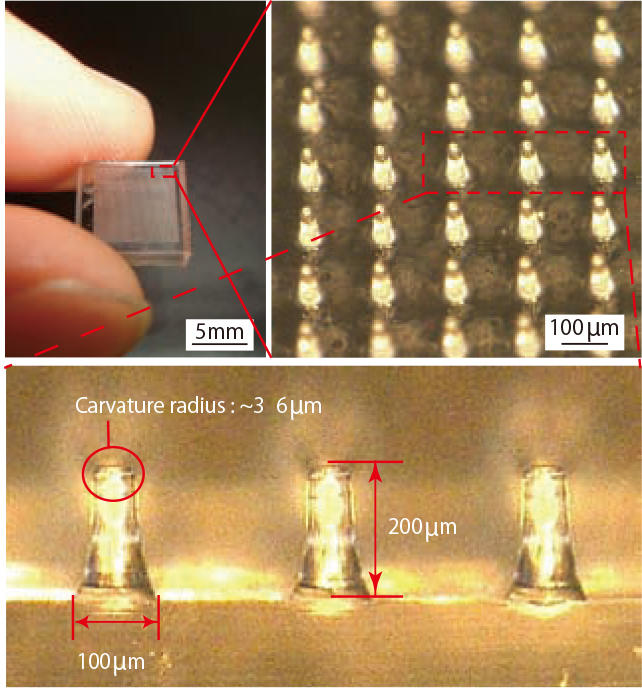
Micro electrodes to detect brainwaves
These easy-to-fit micro electrodes can read brainwaves accurately. MEMS was instrumental in the development of the electrodes.
Interview
Listening to what Assistant Professor Akiko Takeda says
Engaging in robotics research at University of Tokyo
As a small boy, was it your dream to become a research scientist?
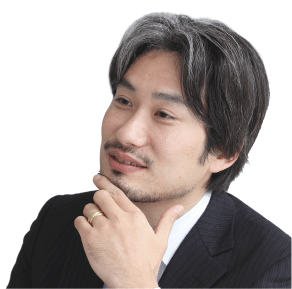
No (laughter). I was born in the city of Tatsuno, Hyogo Prefecture. My family is a long-standing soy sauce maker – an environment having nothing to do with academic research. Fortunately my standing at school was so good that as an elementary school boy I also attended a college-oriented cram school famous for Spartan education. Then I advanced to a college-oriented school with consistent junior and senior high school education, and advanced to the University of Tokyo’s Faculty of Engineering. It was like a natural course of events (laughter). As I recall those young days, I think I could devote myself to studying because I had a number of friends with whom to compete and enjoy learning, rather than because I liked studying.
You mean you didn’t have hard time studying?
Not then but now I’m having hard time (laughter). I may be a type of person who can handle almost anything rather smartly but doesn’t have any particular field at which he is incomparably strong. As such, I chose my course without a definite intention or desire. During the first and second years at the university, I was interested in biology and elementary particle physics. But it was about the time for me to advance to an undergraduate course that a new field of study known as “virtual reality” came into the spotlight. Intrigued, I chose to advance to the Department of Mechano-Informatics. Later I became interested in robotics. When choosing a seminar as a senior, I was admitted to the laboratory of Professors Hirofumi Miura and Isao Shimoyama, the authorities of robotics.
In those days, the “ASIMO” robot was yet to be announced by Honda Motors, and research into biped walking robots and artificial intelligence was almost at a deadlock. Amid such circumstances, in an attempt to find a breakthrough, the laboratory just began studies on micro robotics. Assuming that if a human being is the model for a biped robot, then an insect should be the model for a micro robot, I began studying to create an insect-type robot based on MEMS.
What makes studies on small objects is that a force that can work on an object varies according to the size of the object. For example, if an object’s size becomes one-tenth its original size, its surface area becomes one-hundredth whereas its cubic volume becomes one-thousandth, meaning a drastically reduced force of gravity placed on the object. This is why a flea can jump to a height some 50 times its own height. This in turn means that a robot appropriate for its intended size can be designed by taking such a factor into account. For example, we can even say that the major difference between the wing of aircraft and that of insects mainly comes from the difference in scale.By the way, the topic of my graduation thesis was on a robot controlled by an insect. In this system, the robot moves following the movement of the insect as it walks on a ball.
You made effective use of your biological knowledge, didn’t you?
In this way I had fared as my personal interest went. But it was about that time that I began to think about my future more seriously. My options included succeeding my father in the family business and finding employment with a manufacturing company. As a Master Student, I had an opportunity to attend an overseas academic society meeting, accompanying my professors. I saw them shaking hands with foreign scientists and talking with them frankly. It was so “cool and impressive” that I made up my mind to advance to the doctor’s course (laughter). In fact, I found my life during the doctor’s course very fulfilling.
In those days, there were many opportunities for me to participate in exchange meetings involving different industries. Having talked with people from various industries and different occupations, I came to think that a life different from many others might be good although my way of life until then had been: “Don’t go against the flow.” This thought urged me to advance to the doctor’s course while most of my fellow students found employment in the business world. But I have no regret with my decision. Devoted to research from morning till dawn the next day when crows begin to caw (a little after 3:00 a.m.) – this had been my daily life at the lab back then.
At that time I was immersed in a project to create a tiny (less than 1cm in length) helicopter that can fly when a magnetic field is applied from the outside. When it comes to “flying,” letting wings rotate is much more efficient than letting them flap as insects do. I’m sure it was the smallest helicopter in the world.
It was then that I frequently attended academic society meetings, both in Japan and abroad, which allowed me to deepen exchanges with other young research scientists. Even now I maintain contact with them for information exchange. They are my good colleagues.
Becoming an MIT researcher
After completing the doctor’s course, you found employment with the Massachusetts Institute of Technology (MIT), didn’t you?

Yes, I did. While I was imbued with the idea of going abroad to study after completing my doctor’s course, an MIT professor in charge of the “MIT micro engine project,” in which I was interested, just happened to visit our lab. I asked him if there was a vacancy for a researcher post there. I was told to send the required documents and called to come over for an interview. Then I was happily employed as a member of the project.
You seem to have followed a smooth, favorable path so far.
To begin with, I find myself a type who doesn’t worry too much even when encountering a setback. I hate the idea that you have become stronger because you experienced a failure. Even if you suffer a setback, you shouldn’t be broken – this is my philosophy of life.
I really enjoyed my life at MIT. In the micro engine project, I was making a small, silicon-based gas turbine the size of a button to be used in cellular phone power sources and micro rocket batteries. It was a big project and complete with the best possible equipment and environment.
Boston is home not only to MIT but also Harvard and Boston universities, among others. Many Japanese researchers from diverse fields study there. Once or twice a month exchange meetings were held, where I could meet and talk with many people. This helped greatly broaden my intellectual horizon.
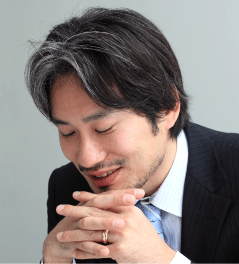
Also worthy of note was the formation of an ice hockey team among Japanese researchers, taking place in the second year of my stay in Boston. Ice hockey was a sport totally new to me. I had never even experienced skating itself before. But it appeared so cool, which lured me to experience hands-on. What encouraged me was a typical reaction of Americans, who never fail to say “Good job!” only if I do my best no matter how poor the performance is. Motivated by this environment, I made up my mind to create a team with myself playing the central role if I were to meet the challenge. Like Japanese, we named our team “Sushis.” The team’s basic rule was “No preliminary inspection.” “Just join and try your hand at it if you are interested” – this was the team policy.
Devoted to MEMS-based research, exerting unrestricted creativity
After fully enjoying your life at MIT for three years, you returned to Japan and came to Keio University, right?
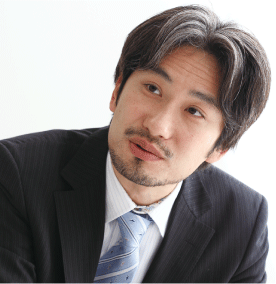
“If I do something, I should do something exciting.” With this determination in mind, I’m addressing research work exerting unrestricted creativity. Under the core theme of MEMS-based human interface, I’m currently handling a variety of research projects such as the sight line detector, tactile sensation display, and gestation/olfaction sensors. My motto, as my teacher Prof. Shimoyama taught me, is “Conceive like an amateur and do the job professionally.” This means that you should do a job with professional skills to produce a perfect result while maintaining an amateur’s inquisitive mindset when conceiving. There are 20 students at my lab, all cheerfully enjoying research work. During our training camp every year, we stage various recreational events and games such as paint ball (two teams using toy guns to shoot paint balls at each other), rafting, softball and so on. Of course they are serious when engaging in research, which is the main purpose. I think a balance between learning and distraction is important. Taking advantage of a weekly colloquium at my lab, we have common knowledge tests among the members. Students take turns coming up with questions on any topic – foreign capital city names, kanji ideographs, history, movies – you name it. I think common knowledge is important because it helps to enhance the quality of our lives. It may surprise you, but knowledge we learned through topics for college entrance examination contains much common knowledge. Speaking of myself, the English language ability I had acquired through entrance exam English turned to be very useful later when making academic presentations and living overseas. Some say cramming is meaningless, but if you have acquired knowledge for education, it can be put to practical use. In fact, I find my common knowledge highly useful when I communicate with foreign people. Topics like Japan’s isolation during the Edo Period are well received by them. Common knowledge must be also useful for expanding the scope of your research work. In addition to the academic basis required of researchers, I would like to foster my students into becoming persons of broad vision.
A student: Dr. Miki is always cheerful, gentle and reliable. Learning many things from what Dr. Miki is doing, we are enjoying our campus life by maintaining a good balance between study and distraction.
(Reporter & and text writer: Madoka Tainaka)


